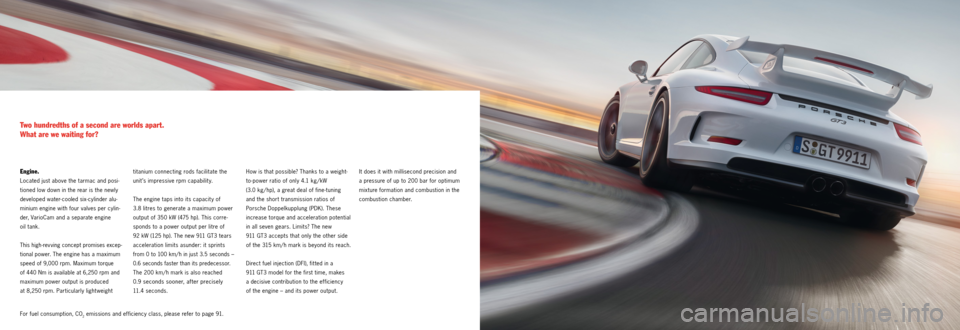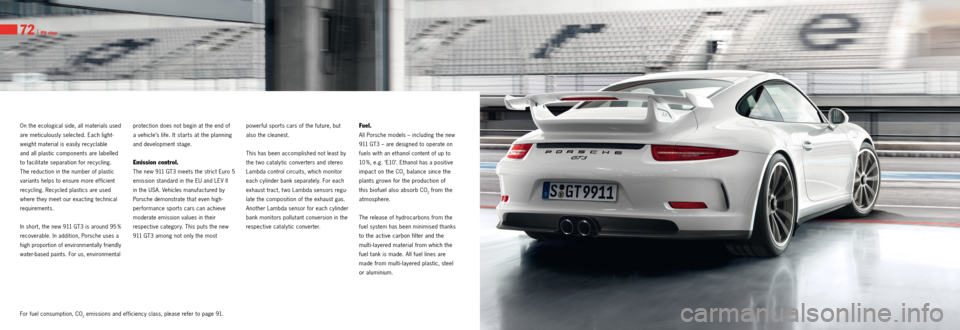light PORSCHE 911 GT3 2013 6.G Information Manual
[x] Cancel search | Manufacturer: PORSCHE, Model Year: 2013, Model line: 911 GT3, Model: PORSCHE 911 GT3 2013 6.GPages: 49, PDF Size: 22.75 MB
Page 7 of 49

12 I The new 911 GT3
Aerodynamics and design.
Clear rules apply at the limit. One of
them being that a sport y design alone is
not enough. Each detail must also serve
a particular function.
The new front end has further improved
the aerodynamics of the centre radiator.
This is revealed to the eye by the custom
ary 911 GT3 air outlet to the front of the
luggage compartment lid. Together with
the wider front spoiler lip, it provides
much more downforce at the front axle.
All cooling air openings are protected by
titanium coloured air intake grilles. These are an indication of what lies at the
centre of the concept: motorsport.
Bi
Xenon headlights are fit ted as stand
ard. Their design is reminiscent of
Porsche motorsport classics. Sleek
direction indicators, daytime running
lights and position lights boasting LED
technology create that contemporary
contrast. LED headlights are also
available as an option.
The mirror base of the SportDesign
exterior mirrors reflects the v shaped
st yling of the wheel spokes and air
intake opening in the front end. Three words sum up the rear: wider,
sleeker, sharper. LED taillights emphasise
the horizontal contouring of the rear.
The central t win tailpipe of the sports
exhaust system is painted black.
From afar, the fixed rear wing visibly
distinguishes the 911 GT3 from a 911.
The wing, wing uprights and rear lid are
made of a light weight synthetic material.
The ram air collector intake is now a
single unit.
That ’s the downforce and engine air
induction prerequisites fulfilled. The
aerodynamics have also been enhanced by the new underbody panelling with
diffuser function at the rear. The result is
considerable downforce for considerable
driving stabilit y and a drag coefficient
of 0.33.
The new 911 GT3 has an even sturdier
and safer stance on the tarmac. Nowhere
does it feel more at home than at the
limit.
Page 10 of 49

Engine.
Located just above the tarmac and posi
tioned low down in the rear is the newly
developed water cooled six cylinder alu
minium engine with four valves per cylin
der, VarioCam and a separate engine
oil tank.
This high revving concept promises excep
tional
power. The engine has a maximum
speed of 9,000 rpm.
Maximum torque
of 440
Nm is available at 6,250 rpm and
maximum power output is
produced
at 8,250 rpm. Particularly light weight
Two hundredths of a second are worlds apart.
What are we waiting for?
titanium connecting rods facilitate the
unit’s impressive rpm capability.
The engine taps into its capacit y of
3.8 litres to generate a maximum power
output of 350 kW (475 hp). This corre
sponds to a power output per litre of
92 kW (125 hp). The new 911 GT3 tears
acceleration limits asunder: it sprints
from 0 to 100 km/ h in just 3.5 seconds –
0.6 seconds faster than its predecessor.
The 200 km/ h mark is also reached
0.9 seconds sooner, after precisely
11. 4 s e c o n d s .
How is that possible? Thanks to a weight
to power ratio of only 4.1 kg / kW
(3.0 kg / hp), a great deal of fine tuning
and the short transmission ratios of
Porsche Doppelkupplung (PDK). These
increase torque and acceleration potential
in all seven gears. Limits? The new
911 GT3 accepts that only the other side
of the 315 km/ h mark is beyond its reach.
Direct fuel injection (DFI), fitted in a
911 GT3 model for the first time, makes
a decisive contribution to the efficiency
of the engine – and its power output. It does it with millisecond precision and
a pressure of up to 200 bar for optimum
mixture formation and combustion in the
combustion chamber.
For fuel consumption, CO
2 emissions and efficiency class, please refer to page 91.
Page 16 of 49

30 I Ideal line
Chassis.
The chassis of the new 911 GT3 has
been engineered to meet the challenging
demands of motorsport – and for this
reason it also provides extremely sport y
day to day driving. The ride height of the
new 911 GT3 is 30 mm lower than that
of the 911 Carrera. In conjunction with
a series of specifically tuned chassis
components, this offers extraordinary
agilit y, a high degree of driving safet y and
stable handling, particularly in corners.
The independent front suspension
combines McPherson type struts with
Being proactive, not reactive. Being there now, not soon.
Instantaneous, not immediate. There is no room for hesitation at the limit.
longitudinal and transverse links. The
rear axle has a multi link suspension,
following the LSA (Light weight, Stable,
Agile) concept. Height, camber, track
and the anti roll bars can be individually
adapted for use on the racetrack.
Additional ball joints on the front and
rear axles help to establish a particularly
firm connection between the chassis
and the body.
An optional lift system at the front axle
raises the front end by 30 mm. Operable
up to a speed of approximately 50 km/ h, it minimises the risk of grounding on
kerbs, ramps and car park entrances.
Rear-axle steering.
Fit ted as standard, the new rear
axle
steering combines performance and
everyday practicality. An electromechani
cal adjustment system at each rear wheel
enables the steering angle to be adapted
based on the current driving situation,
steering input and vehicle speed.
The advantage for day to day driving:
during low speed manoeuvres, the
system steers the rear wheels in the
opposite direction to that of the front wheels. This has the virtual effect of
shortening the wheelbase. The turning
circle is reduced to make it easier to
park. The advantage for sport y driving:
during high
speed manoeuvres, the sys
tem steers the rear wheels in the same
direction as that of the front wheels.
Driving stabilit y is increased by the virtual
extension of the wheelbase and agilit y
is enhanced by the simultaneous steering
of the front and rear axles, especially
during overtaking manoeuvres on the
racetrack.
Page 21 of 49

Reserves I 41
Brakes.
At the limit, you need one thing above all:
reserves. Not only for power, but for
safet y, too. This is possible only with a
raceproven technology on which the
driver can depend at all times. Only this
can free up extra room for manoeuvre,
especially in the red zone.
The new 911 GT3 is therefore equipped
with a particularly powerful yet light
weight brake system with a specifically
Driving at the limit.
But never beyond.
matched brake booster. The red six piston
aluminium brake calipers on the front axle
and the four piston equivalents at the
rear are designed as monobloc units. This
makes them tougher and enables a more
rapid response and release of the brake,
even under heav y loads.
That’s not all. The brake dimensions on
the new 911 GT3 have been enlarged to
cope with the increase in engine power.
The brake discs are 380 mm in diameter not only at the front but now also at
the rear. Thanks to their t wo piece
construction with cast iron brake discs
and aluminium brake chambers, they
reduce weight and thus the unsprung
and rotating masses. The brake discs
are cross drilled and internally vented
for powerful braking even in adverse
weather conditions. Or when pitted
against the challenges of motorsport.
Page 22 of 49

Reserves I 43
Porsche Ceramic Composite Brake
(PCCB).
From the start, Porsche has been synony
mous with motorsport. Ever since 1948,
we have pushed the boundaries of
dynamic performance on the racetrack.
We have taken the experience we have
gained and applied it directly to the road.
The optional Porsche Ceramic Composite
Brake (PCCB) is a fine example. In numer
ous race series, including the Porsche
Mobil 1 Supercup, it has been proven to
withstand the harshest demands of the
track.
Nevertheless, resting on our laurels isn’t
our st yle. That ’s why we have also adapt
ed PCCB dimensions to match the perfor
mance capabilities of the new 911 GT3. The cross
drilled ceramic brake discs are
now 410 mm in diameter at the front
and 390 mm at the rear for even more
formidable braking performance.
The use of six piston aluminium mono
bloc fixed brake calipers on the front
axle and four piston units at the rear –
all finished in yellow – ensures extremely
high brake forces which, crucially, are
exceptionally consistent.
PCCB enables shorter braking distances
in even the toughest road and race
conditions. Excellent fade resistance
provides greater balance when slowing
from racetrack speeds.
The key advantage of PCCB is the
extremely low weight of the ceramic
brake discs, which are approximately
50 % lighter than standard discs of a
similar design and size. As well as
enhancing performance and fuel econ
omy, this represents a major reduction
in unsprung and rotating masses.
This results in bet ter road holding and
increased comfort, particularly on uneven
roads, as well as greater agilit y and
improved handling.
Please note that circuit racing, trackday
use and other forms of performance
driving can significantly reduce the
service life of even the most durable
pads and discs. As with conventional high
performance braking systems, we
recommend that all brake components
be professionally inspected and replaced
where necessary after every track event.
Driver and passenger airbags.
We use advanced airbag technology in
the form of full size driver and front pas
senger airbags, which are inflated in t wo
stages depending on the severit y and
t ype of accident (e.g. frontal or offset
frontal). In less serious accidents, the air
bags are only partially inflated, thereby
minimising discomfort to the occupants.
Porsche Side Impact
Protection System (POSIP).
POSIP, fit ted as standard, consists of
side impact protection beams in the
doors and t wo side airbags on each side:
an integral thorax airbag is located in
each seat side bolster and an upwards
inflating head airbag is incorporated
within each door.
Additional safety features include the
headrests which form an integral part of
each seat, an energy absorbing steering
column, three point seat belts with pre
tensioners and force limiters and energy
absorbing elements in the dashboard.
Page 27 of 49

2
1 32
1 3
52 I Cockpit
Interior materials.
Durability, stability and resilience. These
are the essential ingredients for materials
in a sport y environment. It is an environ
ment dominated by Alcantara, leather and
interior parts in Galvano Silver as well
as brushed aluminium. Here, materials
must be practical – and top qualit y. The
fact that they also have the motorsport
feel is a welcome bonus.
Alcantara is easy to grip and maintain.
For this reason, it is mainly found in
places where there is direct contact: on
the steering wheel rim and gear selector
as well as on the door handles, door
armrests and lid of the centre console
storage compartment. The rooflining
and C pillar trims are also finished in
A lcantara.
Steering wheel.
Change gear like a motorsport profes
sional with the GT3 SportDesign steering
wheel with gearshift paddles. In the new
911 GT3, the shift throw of the paddles
has been further reduced by 50 %.
Gearshifts become even more direct
and precise.
The GT3 SportDesign steering wheel
offers up to 40 mm of height and reach
adjustment. The steering wheel rim
in black Alcantara is easy to grip and
remains in firm hands, even on sport y
drives.
The top centre marking is another
characteristic feature.
Sports seats Plus.
Sports seats Plus are fit ted as standard
in the new 911 GT3 and come equipped
with elevated side bolsters, electric seat
height and backrest adjustment and
manual fore/aft adjustment. The seat
side bolsters are upholstered in leather
and the seat centres are lined in black
Alcantara. The headrests are embroi
dered with the ‘GT3’ logo.
The side bolsters on the seat squab and
backrest have a firm, sport y padding and
offer excellent lateral support. The back
rest shell is finished in Silver Grey.
Sports bucket seats.*
Available as an option are light weight
racing seats with folding backrest,
integrated thorax airbag and manual
fore/aft adjustment for driver and
passenger.
The carbon surface finish conceals
a seat shell in glass /carbon fibre
reinforced plastic. The backrest pivots
are positioned high in the side bolsters to
provide excellent lateral support to the
pelvic region. The seats are upholstered
in black leather as standard with seat
centres finished in Alcantara. The ‘GT3’
logo is embroidered on the headrests.
Adaptive Sports seats Plus.
Available on request, adaptive Sports
seats Plus blend sport with comfort and
are suitable for everyday driving or the
racetrack. They feature side bolsters
in leather, seat centres in black Alcantara
and an embroidered ‘GT3’ logo on the
headrests. Of fering 18 way electric
adjustment, the seats can be optimally
adapted to meet your needs in terms of
seat height, squab and backrest angle,
seat depth, fore/aft adjustment and four
way lumbar support. The side bolsters on
the seat surface and backrest can be
individually adjusted for precision lateral
support on winding roads and added
comfort on long journeys.
* Child seats are not compatible with the
Sports bucket seats.1 Sports bucket seat 2 Sports seat Plus 3 Adaptive Sports seat Plus
Page 31 of 49

60 I Pit stop
Motorsport.
Competing for every hundredth of a
second and calling on over 60 years of
experience – that ’s Porsche Motorsport.
But what ’s our motivation? Everyone
who drives us forward with 100 % passion
and expertise – from the driver to the
engineer. On all racetracks in the world.
Everyone who shares the same dream,
a dream that has been a realit y for
generations: Ferry Porsche’s dream of
a car that ought to be just as capable
of winning as it is suitable for everyday
use. And has so far led to more than 30,000 racing victories. Take, for exam
ple, the Porsche 956 – one of the most
successful race cars of all time. Not
to forget the other cars that promise
the very same potential, such as the
911 GT3 RSR or the 911 GT3 Cup.
Two racing machines that have proven a
success in circuit and endurance events.
As successful as the entire brand, Porsche
Motorsport has so far built more than
3,000 race cars, over 1,000 of which are
still in use today. They appear at the
lowest amateur levels and line up at the very pinnacle of the sport, competing
in US GT races and in over 19 one make
championships, including the Porsche
Carrera Cup Germany and the Porsche
Mobil 1 Supercup. New destinations
await, not least the 24 Hours of Le Mans
in 2014. A protot ype newly conceived
from the ground up is set to take to the
grid with a view to extending the run
of 16 outright wins at the Sarthe circuit.
For Porsche, however, what matters even
more than a place on the winners’ podi
um is how much experience is gained, as well as the ideas and visions that the
race inspires. All findings from the race
track are transferred into series produc
tion as design and test principles. Our
exhaust turbocharging or double clutch
transmission technologies are t wo exam
ples. This proximit y bet ween the race
track and the road is unique. It lets every
Porsche customer take part in the race –
directly or indirectly. It lets the customer
feel what drives us. Yesterday, today
and tomorrow: Spirit. Vision. Principle.
For all those who are not thinking about the 7:30 early flight to London.
And are thinking instead about lap times on the Nürburgring.
Page 32 of 49

Pit stop I 63
GT racing.
‘GranTurismo’ or GT racing cars are
exclusively prepared for competition
use. However, regulations state that they
must be based on road legal cars, with
modifications restricted to a few specific
areas. In the early 1990s, Porsche was
the driving force behind the renaissance
of international GT motorsport. In the
meantime, Porsche has established suc
cessful collaborations with customer
teams. Porsche supplies the race ready
cars and supports private teams with
further development, technical services
and the provision of factory drivers.
Whether it ’s in the 24 Hours of Le Mans,
the ALMS, the International GT Open
or at national GT championships, Porsche
private teams are regular race and
championship winners.
GT3 Cup Challenges.
The gateway to semi professional motor
sport. Race locations include Australia,
Brazil, Central Europe, Great Britain,
Japan, Scandinavia, Switzerland, USA,
Canada and the Middle East. Races
are governed by the regulations of the
Porsche Carrera Cup Germany. The
prerequisite to participation is a national
licence.
Porsche Carrera Cups.
From the fastest one make championship
in Germany to the international top event.
The Porsche Carrera Cups play host in
many countries to first class motorsport
highlights, such as the German Touring
Car Masters (DTM) or, most recently, the
24 Hours Nürburgring. The tradition of
the Porsche Carrera Cup spans over 20 years. Since the first Porsche Carrera
Cup Germany was staged in 1990, a
further seven Porsche Carrera Cups have
become established in France, Great
Britain, Scandinavia, Italy, Japan, Asia
and Australia. Races are held on almost
every weekend of the motorsport season.
The passion to win fuels the fight for
ever y single millimetre: young upstarts
challenge old hands, amateurs compete
with professionals and rookies take on
experienced customer drivers.
Porsche Mobil 1 Supercup.
The pinnacle of the one
make champion
ships. Since 1993, the Porsche Mobil 1
Supercup has been held as part of the
FIA Formula One World Championship –
and as the only Gran Turismo race series.
All cars are supported by professional racing teams, which use t wo to three
racing cars in the championship. The
events take place mainly as part of the
European Grand Prix, with a race dis
tance of approximately 70 kilometres.
The drivers, which include established
personalities alongside promising new
talent, give every thing they have from
start to finish. After all, another prize
might just be up for grabs: a career in
GT racing.
For further information, please visit
www.porsche.com/motorsport.
Page 36 of 49

Environment.
We’ve already spoken about our contribu
tion to motorsport. To be more precise,
about our responsibility for the future of
motorsport. We meet this responsibility
with intelligent technology, unconven
tional ideas and optimum performance.
Our approach to environmental protec
tion is no different. In an era of intensify
ing debate about global climate change
and CO
2 emissions, every automotive
manufacturer is asking what it has to
offer right now. Our answer has long
been the same: high power output
combined with high efficiency.
Porsche has managed to reduce fuel
consumption significantly across all
model ranges compared with the respec
tive previous model even though perfor
mance has been increased. This is made
possible by an efficient drive concept,
lightweight construction, optimised
aerodynamics and low rolling resistance.
The environmental management team
at the Porsche Development Centre in
Weissach aims to demonstrate a high
level of environmental responsibility. Here, technological developments are
carried out with environmental protection
in mind. The goal is to enhance perfor
mance – but preferably not at the expense
of the environment.
Fuel economy and recycling.
Intelligent lightweight construction has
been part of Porsche DNA since 1948 –
for both technological and ecological
reasons. And, of course, with competitive
advantages in mind. In motorsport, weight
is increasingly the number one factor
of success. Lightweight construction is
therefore the basis for low consumption
The true challenge:
not merely getting faster, but better.
values combined with outstanding
performance.
On the technical side, various compo
nents are made with a high proportion
of aluminium, magnesium, plastics and
super high strength sheet steel. The
materials used have been selected for
their abilit y to withstand load, yet they
are considerably lighter overall than
conventional steel.
Pit stop I 71
Page 37 of 49

On the ecological side, all materials used
are meticulously selected. Each light
weight material is easily recyclable
and all plastic components are labelled
to facilitate separation for recycling.
The
reduction in the number of plastic
variants helps to ensure more efficient
recycling. Recycled plastics are used
where they meet our exacting technical
requirements.
In short, the new 911 GT3 is around 95 %
recoverable. In addition, Porsche uses a
high proportion of environmentally friendly
water based paints. For us, environmental protection does not begin at the end of
a vehicle’s life. It starts at the planning
and development stage.
Emission control.
The new 911 GT3 meets the strict Euro 5
emission standard in the EU and LEV II
in the USA. Vehicles manufactured by
Porsche demonstrate that even high
performance sports cars can achieve
moderate emission values in their
respective category. This puts the new
911 GT3 among not only the most powerful sports cars of the future, but
also the cleanest.
This has been accomplished not least by
the t wo cataly tic converters and stereo
Lambda control circuits, which monitor
each cylinder bank separately. For each
exhaust tract, t wo Lambda sensors regu
late the composition of the exhaust gas.
Another Lambda sensor for each cylinder
bank monitors pollutant conversion in the
respective cataly tic converter.
Fuel.
All Porsche models – including the new
911 GT3 – are designed to operate on
fuels with an ethanol content of up to
10 %, e.g. ‘E10’. Ethanol has a positive
impact on the CO2 balance since the
plants grown for the production of
this biofuel also absorb CO
2 from the
atmosphere.
The release of hydrocarbons from the
fuel system has been minimised thanks
to the active carbon filter and the
multi layered material from which the
fuel tank is made. All fuel lines are
made from multi layered plastic, steel
or aluminium.
For fuel consumption, CO2 emissions and efficiency class, please refer to page 91.
72 I Pit stop